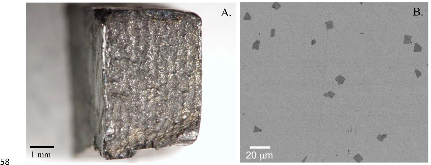Application of the Uranium–Helium Chronometer to the Analysis of Nuclear Forensic Materials
Abstract
Radiochronometers are used to constrain the manufacturing and processing history of actinide materials for nuclear forensic investigations. This paper describes here U–He ages and He diffusion kinetics obtained from a metallic, highly enriched uranium sample. The average U–He age is 8% older than the known casting date, which indicates that excess He is present and is likely due to incomplete degassing of pre-existing He during the casting process. Although the U–He age is older than expected, the accuracy is comparable to other chronometers that have been applied to this material. Diffusion kinetics obtained from the uranium metal indicate that He is quantitatively retained under plausible storage conditions.
- Authors:
-
- Lawrence Livermore National Lab. (LLNL), Livermore, CA (United States). Nuclear and Chemical Sciences Division
- Publication Date:
- Research Org.:
- Lawrence Livermore National Lab. (LLNL), Livermore, CA (United States)
- Sponsoring Org.:
- USDOE; LLNL Laboratory Directed Research and Development (LDRD) Program
- OSTI Identifier:
- 1512619
- Report Number(s):
- LLNL-JRNL-702173
Journal ID: ISSN 0003-2700; 835800
- Grant/Contract Number:
- AC52-07NA27344
- Resource Type:
- Accepted Manuscript
- Journal Name:
- Analytical Chemistry
- Additional Journal Information:
- Journal Volume: 88; Journal Issue: 24; Journal ID: ISSN 0003-2700
- Publisher:
- American Chemical Society (ACS)
- Country of Publication:
- United States
- Language:
- English
- Subject:
- 46 INSTRUMENTATION RELATED TO NUCLEAR SCIENCE AND TECHNOLOGY
Citation Formats
Gates, Sean D., and Cassata, William S. Application of the Uranium–Helium Chronometer to the Analysis of Nuclear Forensic Materials. United States: N. p., 2016.
Web. doi:10.1021/acs.analchem.6b03502.
Gates, Sean D., & Cassata, William S. Application of the Uranium–Helium Chronometer to the Analysis of Nuclear Forensic Materials. United States. https://doi.org/10.1021/acs.analchem.6b03502
Gates, Sean D., and Cassata, William S. Fri .
"Application of the Uranium–Helium Chronometer to the Analysis of Nuclear Forensic Materials". United States. https://doi.org/10.1021/acs.analchem.6b03502. https://www.osti.gov/servlets/purl/1512619.
@article{osti_1512619,
title = {Application of the Uranium–Helium Chronometer to the Analysis of Nuclear Forensic Materials},
author = {Gates, Sean D. and Cassata, William S.},
abstractNote = {Radiochronometers are used to constrain the manufacturing and processing history of actinide materials for nuclear forensic investigations. This paper describes here U–He ages and He diffusion kinetics obtained from a metallic, highly enriched uranium sample. The average U–He age is 8% older than the known casting date, which indicates that excess He is present and is likely due to incomplete degassing of pre-existing He during the casting process. Although the U–He age is older than expected, the accuracy is comparable to other chronometers that have been applied to this material. Diffusion kinetics obtained from the uranium metal indicate that He is quantitatively retained under plausible storage conditions.},
doi = {10.1021/acs.analchem.6b03502},
journal = {Analytical Chemistry},
number = 24,
volume = 88,
place = {United States},
year = {Fri Nov 18 00:00:00 EST 2016},
month = {Fri Nov 18 00:00:00 EST 2016}
}
Web of Science
Figures / Tables:
 Figure 1: A. The ITWG – RR3 HEU material was extracted from a hollow cylindrical casting. An optical image of sample before sub-sectioning is shown. Interior pieces of the metal sub-sample were extracted using a diamond saw for U – He analyses. B. Scanning electron microscope backscattered electron micrograph showingmore »
Figure 1: A. The ITWG – RR3 HEU material was extracted from a hollow cylindrical casting. An optical image of sample before sub-sectioning is shown. Interior pieces of the metal sub-sample were extracted using a diamond saw for U – He analyses. B. Scanning electron microscope backscattered electron micrograph showingmore »
Figures / Tables found in this record:

 Search WorldCat to find libraries that may hold this journal
Search WorldCat to find libraries that may hold this journal